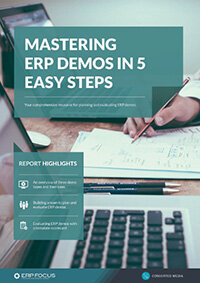Gaining maximum benefit from ERP presentations
There are several different stages in an ERP project, beginning with the writing of an Invitation to Tender (ITT), and many of these stages are discussed in detail on this website. One stage, the supplier presentation or demonstration, is frequently taken for granted or at least under-valued because its significance in the process is not fully understood.
The selection process starts with the ITT and from this document, companies can start to create a longlist of possible suppliers of systems that appear to offer what they want within a budget that they can afford. When the ITT responses have been analyzed, it's time to create a shortlist for detailed scrutiny.
When looking at Tier 1 systems which cost tens or even hundreds of millions this may, in fact, be only one system, but with Tier 2 and Tier 3 solutions, this is more usually between four and six. (Looking at too few systems runs the risk of not getting a full picture of what is available, whilst looking at too many simply causes confusion.) The key to getting the most out of supplier presentations lies in understanding that the supplier and the customer have differing ideas about what they want to get from it.
The supplier perspective
There are ERP companies that try to cut corners (and this and other articles on this website will help you to identify who they are) but good companies, by the time they get to the presentation stage, will have invested a lot of time and effort. There will have been sales visits, there will have been time spent on analyzing the ITT and considering how to resolve any apparent gaps in functionality, and there will have been time spent on preparing the presentation itself.
The amount of time that suppliers will feel comfortable investing will differ according to system size, so Tier 1, 2 and 3 suppliers will all approach presentations differently.
Starting at the bottom, Tier 3 system suppliers don't make a lot of profit on any one deal because the total price of a system, including implementation, will be in the tens of thousands and a chunk of that will have to be paid to the system authors. Much as they would like to pour resources into getting a deal, that just wouldn't make financial sense and, in fact, they will frequently allocate only one implementation consultant to each contract in an effort to minimize costs.
Unfortunately, that means the consultant who advises you on how to best set up your accounting system is also the person who advises you on how to set up your manufacturing and distribution systems. Ironically, Tier 3 consultants are frequently more skilled than most because they have to be a jack of all trades and for small or simple implementations, that can actually be very useful.
They also keep down the cost of sale (and therefore price) by allowing only one consultant to be used during the presentation phase rather than the large teams that large systems demand.
Moving to Tier 2 suppliers (typically systems with 6-figure price tags, but occasionally 7), things start to change. With the higher prices comes a higher profit on each individual sale, so it becomes easier to justify investing more time in the sales process. That means extra time to resolve functionality gaps (that should be fewer anyway) and also allows some customization and bespoke modifications to resolve key issues.
Tier 2 suppliers will also have extra functionality that they will be keen to demonstrate. They will be aware of their system's strengths and will want to highlight these during their presentation. Not everything that they can show will be relevant to every company and a well-written ITT will help to keep things on track because it tells them what is important and what the customer wants to see.
Tier 1 suppliers have a major problem with software demonstrations because their systems are simply too big to demonstrate. Although rich in functionality, that comes at a price. Their systems require an enormous amount of configuration to get them to work and the cost and the time required to do that means that they, and their system integration partners, must rely on presentations rather than demonstrations.
By necessity, they had to become masters of 'demonstration by PowerPoint', so their presentations are about selling themselves as business partners and only at a superficial level about the systems themselves.
So they will focus on things like their size and the number of trained consultants they have, and on the size and range of their customer base and may even claim that detailed presentations are not required because their system 'reflects best practice'. In truth; by the time a prospect for a Tier 1 system gets to this stage, they have generally already accepted that the software can do what they want and they are usually more interested in benefits than functionality.
Continuing reports of multi-million ERP failures suggest that this approach is not entirely without risk but, in fairness to Tier 1 suppliers and their system integration partners, there is not much more they can do. True; most claim to have pre-configured industry templates to speed implementation but they are reluctant to demonstrate this pre-sale, in case they differ from their customer's expectations.
The customer perspective
The way customers perceive a presentation is in large part dependent upon their previous experience of the ERP selection cycle. Companies probably only go through the process every ten years or so (and maybe not even that) and in consequence, the team will largely be made up of people who have limited experience of what to expect.
Many users coming to their first presentation will hope to see a prototype or at least a proof of concept of the system offered. Frequently they will have supplied the vendor or system integrator with sample data and will want to see that used in any demonstration.
How realistic this presentation is depends on the size of the system because, as previously explained, Tier 1 suppliers cannot hope to configure a system just for a demonstration. It is certainly realistic to expect Tier 3 vendors to load some of the prospect's data but companies have to accept that the system demonstrated is unlikely to be a glove fit for their requirements and some workarounds will be necessary before the system goes live.
A good salesperson will always set their expectations in advance but how close the demonstrated system gets to a realistic portrayal of the definitive system depends on how much time the supplier's pre-sales consultants have had to prepare. With Tier 3 systems, they will typically have only a few days to review the ITT, configure the system accordingly, and load data.
On a more positive note, assuming all potential suppliers have the same amount of time for preparation, the customer has a very good chance of seeing which potential providers can best demonstrate an understanding of their needs. Put bluntly: if prospective suppliers don't address the business problems detailed in the ITT during their presentations, they are only interested in selling to you and not in helping you.
One final recommendation is that customers should 'own' the presentation. The ERP supplier will try to control and direct the presentation because they know their system and they know what they want to highlight and what they want to avoid. Many companies turn up for their presentation totally ill-prepared.
At the very least, they should bring a copy of their ITT to check that all of their wants and needs have been addressed, and they should bring notebooks to record the claims and promises of prospective suppliers. These notes need to be detailed because, following the presentation, they will be the basis of e-mails to the suppliers along the lines of, “This is what we understood from your presentation. Please confirm that we understood correctly”.
Promises and claims that are not confirmed in writing are meaningless and, if a supplier declines to concur, they are actually sending you a very clear and important message. Both parties should keep in mind companies spend a lot of money on their new ERP system and deserve the best they can afford.
Free white paper

ERP software buyer's guide
Save hours of ERP selection research with this comprehensive buyer's guide

Featured white papers
-

ERP Software Pricing Guide
Get the latest pricing information on over 80 popular ERP systems, and learn how to budget for your ERP project in our free guide
Download -

60-Step ERP Selection Checklist
Get the comprehensive checklist for your ERP selection project
Download -

ERP Demo Guide & Scorecard
Master your ERP demo with 5 easy steps using our free guide (includes demo scorecard)
Download
Related articles
-

The best ERP systems for process manufacturing
Consider these ERP systems when selecting your next process manufacturing ERP
-

Secret KPI: Why Your ERP Implementation Team Matters More Than Software
Learn how Godlan ensures successful ERP implementation for manufacturers with proven strategies &...
-

5 ERP pricing definitions you need to understand
Have you mastered the ERP pricing lexicon yet? Getting to grips with these five definitions is a ...

